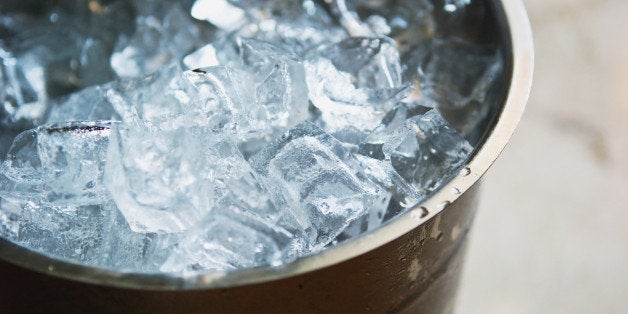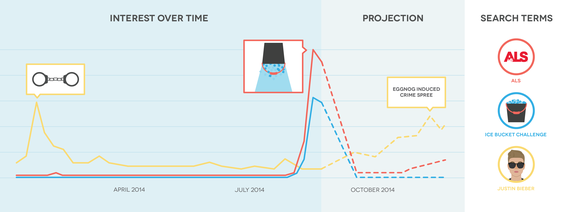
It is a rare moment when our collective attention turns toward causes as worthy as ALS. The Ice Bucket Challenge has become an example of the increased awareness and fundraising that can result from the combination of creativity, social media and a compelling cause.
Like all media campaigns, this one also has its cynics. They point to a disconnect between awareness and action, and cite the many people dousing themselves with cold water without any understanding of the disease inspiring their unpleasant bath.
To all of these people I say searches for "ALS" in August just passed Justin Bieber in search interest. What's more, for 2014, "ALS" searches just surpassed Justin Bieber's infamous arrest in search interest in the US. After watching Justin's iceless bucket challenge video, I decided to explore this further using a mix of Google Trends and AdPlanner tools.  Image by Ann Nguyen. Source: Google Trends
Image by Ann Nguyen. Source: Google Trends
Search as a proxy for awareness
For the past decade, "ALS" searches have hovered around 1.1 million searches per month. The last month, we've seen that go from 1.1 milllion to an all-time high of 21.8 million. Search volume is our best indicator of aggregate interest -- an unconscious reflection of the world's quest for information. These data have been predicted elections and the spread of the flu. Someone who thinks they have the flu searches for "flu symptoms" in the same way that someone curious about ALS searches "what is ALS?"
One of the chief concerns among critics is that the branded activity -- the "Ice Bucket Challenge" is the real beneficiary of the campaign with little peripheral benefit to ALS more broadly. The data suggest otherwise.
When comparing searches for "Ice Bucket Challenge" vs. "ALS" it is clear that ALS searches are far higher than the branded bucket activity by about 40 percent.
Given the media and Google searching frenzy that followed Justin Bieber's January arrest, let's use that as a benchmark. Users searched terms related to that incident 10.9 million times. As of publication, ALS has been searched almost time times more -- and nobody got arrested!. By using the Google AdWords keyword planner we can get an idea of the volume of searches by month, something Google Trends doesn't show.
Breaking down "awareness"
How can we really quantify and measure a generic but ubiquitous term like "awareness?" At what point can we really say someone has become "aware" of a cause, and what does "being aware" really mean? For the sake of ALS, it should be more than watching an ice bucket video or doing a single search for the topic.
For ALS and similar altruistic causes, the benefit of raising "awareness" is in its ability to raise funds or facilitate other offline action, similar to how a for-profit brand would consider a sale as the goal of its campaign. The marketing industry has established that, on average, seven advertising impressions are necessary to influence a customer to purchase a product, so let's use seven as our threshold for donations to ALS.
Calculating awareness
So I know everyone isn't the biggest fan of math, but this is a pretty simple equation that can start us thinking about quantifying this vague goal:
(Donations + Videos created + people with seven impressions) * est. overlap percentage
- Donations are fairly easy to calculate if you break down the 94 million into 100 donations -- the average challenge donation size (July 24th-August 27th). (940k)
- Videos created indicates that someone took the time to get water, ice, rehearse an ALS ice bucket speech, record the event and post it online. (1.2 million aware)
- People with seven impressions is a bit harder without access to ALS' Google Analytics.
- One approach to take the total estimated searches for ALS in August - 21.8 million and then assume a power law dynamic where 90% of people leave after finding out some information, but 10 percent of people become engaged in the issue leading to seven+ impressions. (2.18 million aware)
- Total the amount of times these videos were watched because this also counts as an impression. 4.5 million videos on YouTube + 1.2 million videos on Facebook leading to roughly 4.5 billion views. (45 million aware --Bill Gates has 17 million views alone!)
- Total amount of people reading ice bucket challenge news coverage 34.2m articles (+1 for this article) in the news with "ice bucket challenge" (recorded 8/25/14). Again -- apply an assumed power law around people that read and watch these media. (4m aware)
Awareness goals also assume that each person you reach has an equal value. We can forget when calculating a quantitative measure we ignore a more important qualitative one. If I were trying to move the needle on funding and support for ALS research I would want to reach politicians in control of policy. Consider the amount special interest lobbyists spend on making sure their messages are heard in Washington. Now balance that with the fact that the majority of the politicians that voted for the 2011 cuts in ALS funding have done the bucket challenge, not to mention the president himself has agreed to personally donate to ALS. Ultimately, this rise in awareness and donations may actually lead to policies that better support those affected by ALS.
Data don't lie (people do)
- Searches for "ALS" are 40 percent higher than "Ice Bucket Challenge," and both are currently beating interest in Justin Bieber
- "ALS" was searched for roughly 21.8m times, peaking as of August 27th during the ice bucket challenge
- ALS.org reported $94 million since July 24th, compared with $2.2 million in the same period last year.
- +1.2 Million Videos posted to Facebook (New York Times)
- Estimated water dumped:
- +4.81 millions gallons (assuming 4 gallons/bucket as of 8/25)
- A half inch of rain to cover the National Mall in DC
- Enough to make Californians cry, then use their tears to water plants.
- Number of times "slactivism" was mentioned in ice bucket articles: 69,500 (as of 8/22)
- Bieber Fever will be completely cured by December 2018
#Winning
Mr. Frates' goals were to raise awareness and money for this terrible disease. Even in my most critical opinion the ice bucket challenge has been an absolute home run and it isn't even done.
Like watching a wave approaching from the shore, I saw ice water ripple through my network until I was finally challenged by a close friend. I am happy to report that ALS.org is now $100 richer; hopefully they realize that the most valuable thing they've gotten from me is my email address. As the ice water dries up (search interest has officially peaked as of August 23rd), I hope ALS.org thinks carefully about how they foster their new fans.
P.S.If you are interested in the social forces behind this campaign, read our "5 Reasons Why the Ice Bucket Challenge Worked" using academic work from: "Influence" (Cialdini), "Viral Loop: From Facebook to Twitter" (Penenberg), and The Behavioral Model (BJ Fogg). Or you can watch the obligatory ice bucket challenge video that appends every lazy #IceBucketChallenge(d) article.